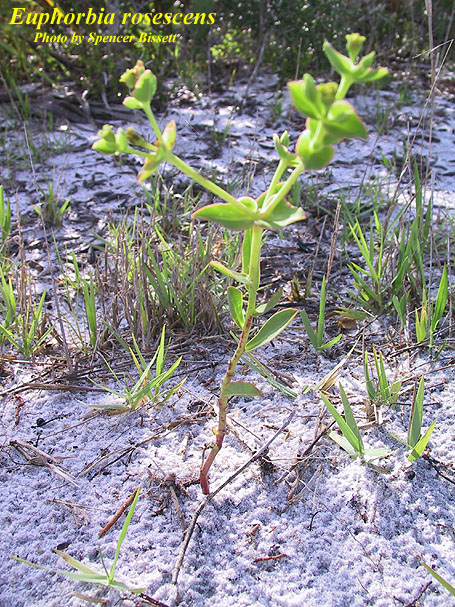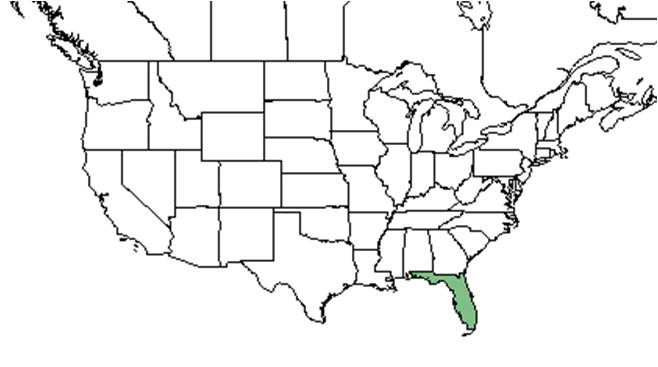Euphorbia rosescens
| Euphorbia rosescens | |
|---|---|

| |
| Photo by Spencer Bissett, Atlas of Florida Vascular Plants | |
| Scientific classification | |
| Kingdom: | Plantae |
| Division: | Magnoliophyta - Flowering plants |
| Class: | Magnoliopsida - Dicotyledons |
| Order: | Euphorbiales |
| Family: | Euphorbiaceae |
| Genus: | Euphorbia |
| Species: | E. rosescens |
| Binomial name | |
| Euphorbia rosescens E.L.Bridges & Orzell | |

| |
| Natural range of Euphorbia rosescens from USDA NRCS Plants Database. | |
Common name: scrub spurge
Contents
Taxonomic notes
Distinguishable from Euphorbia floridana by broader stem leaves that are not reflexed and do not abruptly contrast with ovate bracteal leaves on the inflorescence.[1]
Description
Euphorbia rosescens is a slightly succently, blue-green herb[1] and is often a single stem and can be seen growing in clusters.[2]. The leaves are elliptic to oblanceolate or obovate-spatulate.[1] Flowers are unisexual and occur in cyathia that develop acropetally and are arranged on a compound inflorescense.[2]
Distribution
Distribution is limited to a 50 kilometer range on the well drained sands of the Lake Wales Ridge[3]. There are fewer than 20 known sites[4].
Ecology
Habitat
Habitat is limited to the xeric, white sand entisols of the Lake Wales Ridge. Within the ridge, it can be found in sand pine scrubs, scrubby flatwoods, and disturbed areas along sandy roads and fire breaks[2]. It has been observed to tolerate some disturbance[4].
Phenology
The flowers of E. rosescens are unisexual and occur within cyathia that develop acropetally, arranged on a compound inflorescense[2].
Pollination
The following Hymenoptera families and species were observed visiting flowers of Euphorbia rosescens at Archbold Biological Station: [5]
Sphecidae: Bembecinus nanus floridanus, Tachysphex apicalis, T. similis, Tachytes mergus
Vespidae: Leptochilus krombeini
Conservation and management
Range is limited to Highlands county on the Lake Wales Ridge, and there are fewer than 20 known sites. The ridge is quickly being converted into agricultural lands and urban development. The existing scrubs are becoming overgrown with fire suppression [4]. Archbold currently monitors this species [6].
G1-critically imperiled[4].
Cultivation and restoration
Photo Gallery
References and notes
- ↑ 1.0 1.1 1.2 [NatureServe]Accessed: December 11, 2015
- ↑ 2.0 2.1 2.2 2.3 [Archbold Biological Station] Accessed: December 11, 2015
- ↑ [[1]]Accessed: December 11, 2015
- ↑ 4.0 4.1 4.2 4.3 [Encyclopedia of Life]Accessed: December 11, 2015
- ↑ Deyrup, M.A. and N.D. 2015. Database of observations of Hymenoptera visitations to flowers of plants on Archbold Biological Station, Florida, USA.
- ↑ [[2]] Accessed: December 11, 2015